镁安全技术说明书
- 格式:docx
- 大小:19.43 KB
- 文档页数:4
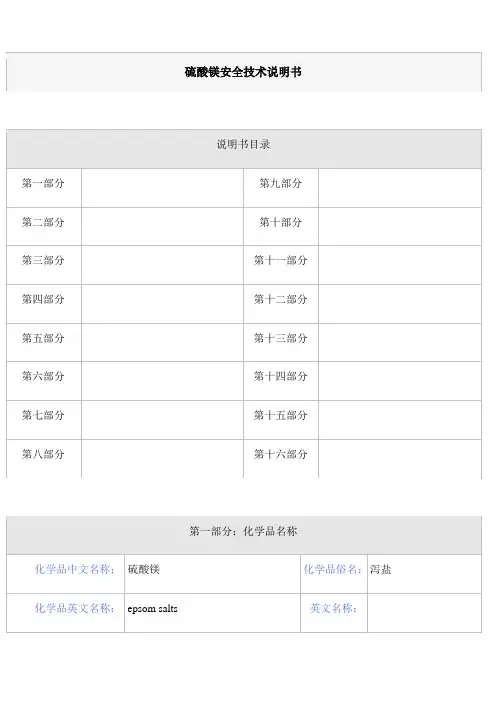
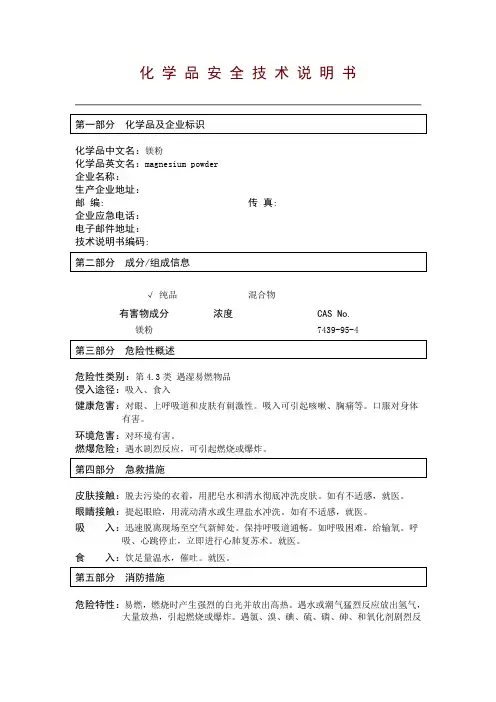
化学品安全技术说明书化学品中文名:镁粉化学品英文名:magnesium powder企业名称:生产企业地址:邮编: 传真:企业应急电话:电子邮件地址:技术说明书编码:√纯品混合物有害物成分浓度CAS No.镁粉7439-95-4危险性类别:第4.3类遇湿易燃物品侵入途径:吸入、食入健康危害:对眼、上呼吸道和皮肤有刺激性。
吸入可引起咳嗽、胸痛等。
口服对身体有害。
环境危害:对环境有害。
燃爆危险:遇水剧烈反应,可引起燃烧或爆炸。
皮肤接触:脱去污染的衣着,用肥皂水和清水彻底冲洗皮肤。
如有不适感,就医。
眼睛接触:提起眼睑,用流动清水或生理盐水冲洗。
如有不适感,就医。
吸入:迅速脱离现场至空气新鲜处。
保持呼吸道通畅。
如呼吸困难,给输氧。
呼吸、心跳停止,立即进行心肺复苏术。
就医。
食入:饮足量温水,催吐。
就医。
危险特性:易燃,燃烧时产生强烈的白光并放出高热。
遇水或潮气猛烈反应放出氢气,大量放热,引起燃烧或爆炸。
遇氯、溴、碘、硫、磷、砷、和氧化剂剧烈反应,有燃烧、爆炸危险。
粉体与空气可形成爆炸性混合物, 当达到一定浓度时, 遇火星会发生爆炸。
有害燃烧产物:氧化镁。
灭火方法:用干燥石墨粉和干砂闷熄火苗,隔绝空气。
灭火注意事项及措施:消防人员必须佩戴空气呼吸器、穿全身防火防毒服,在上风向灭火。
尽可能将容器从火场移至空旷处。
喷水保持火场容器冷却,直至灭火结束。
严禁用水、泡沫、二氧化碳扑救。
施救时对眼睛和皮肤须加保护,以免飞来炽粒烧伤身体、镁光灼伤视力。
应急行动:隔离泄漏污染区,限制出入。
消除所有点火源。
建议应急处理人员戴防尘口罩,戴防尘口罩,穿防静电服。
禁止接触或跨越泄漏物。
尽可能切断泄漏源。
严禁用水处理。
小量泄漏:用干燥的砂土或其它不燃材料覆盖泄漏物,然后用塑料布覆盖,减少飞散、避免雨淋。
粉末泄漏:用塑料布或帆布覆盖泄漏物,减少飞散,保持干燥。
在专家指导下清除。
操作注意事项:加强局部排风。
操作人员必须经过专门培训,严格遵守操作规程。

第1部分化学品及企业标识化学品中文名:镁化学品英文名:MagnesiumCAS号:7439-95-4分子式:Mg分子量:24.31产品推荐及限制用途:工业及科研用途。
第2部分危险性概述紧急情况概述:暴露在空气中会自燃。
遇水放出可自燃的易燃气体。
GHS危险性类别:自燃固体类别1遇水放出易燃气体的物质和混合物类别1标签要素:象形图:警示词:危险危险性说明:H250暴露在空气中会自燃H260遇水放出可自燃的易燃气体防范说明:•预防措施:——P210远离热源/火花/明火/热表面。
禁止吸烟。
——P222不得与空气接触。
——P231+P232在惰性气体中操作。
防潮。
——P233保持容器密闭。
——P280戴防护手套/穿防护服/戴防护眼罩/戴防护面具。
——P223不得与水接触。
•事故响应:——P370+P378火灾时:使用灭火器灭火。
•安全储存:——P402+P404存放于干燥处。
存放于密闭的容器中。
•废弃处置:——P501按当地法规处置内装物/容器。
物理和化学危险:暴露在空气中会自燃。
遇水放出可自燃的易燃气体。
健康危害:无资料环境危害:无资料第3部分成分/组成信息第4部分急救措施急救:吸入:迅速脱离现场至空气新鲜处。
保持呼吸道通畅。
如呼吸困难,给输氧。
呼吸、心跳停止,立即进行心肺复苏术。
就医。
皮肤接触:立即脱去污染的衣着,用肥皂水和清水彻底冲洗。
就医。
眼晴接触:立即分开眼睑,用流动清水或生理盐水彻底冲洗。
就医。
食入:漱口,饮水。
就医。
对保护施救者的忠告:将患者转移到安全的场所。
咨询医生。
出示此化学品安全技术说明书给到现场的医生看。
对医生的特别提示:无资料第5部分消防措施灭火剂:用水雾、干粉、泡沫或二氧化碳灭火剂灭火。
避免使用直流水灭火,直流水可能导致可燃性液体的飞溅,使火势扩散。
特别危险性:遇湿易燃。
燃烧时产生强烈的白光并放出高热。
粉体与空气混合能形成爆炸性混合物,当达到一定浓度时,遇火星会发生爆炸。
灭火注意事项及防护措施:消防人员须穿全身防火防毒服,佩戴空气呼吸器,在上风向灭火。

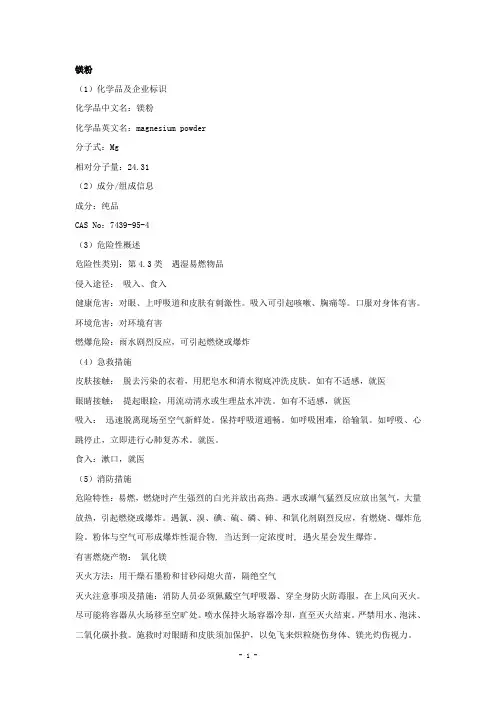
镁粉(1)化学品及企业标识化学品中文名:镁粉化学品英文名:magnesium powder分子式:Mg相对分子量:24.31(2)成分/组成信息成分:纯品CAS No:7439-95-4(3)危险性概述危险性类别:第4.3类遇湿易燃物品侵入途径:吸入、食入健康危害:对眼、上呼吸道和皮肤有刺激性。
吸入可引起咳嗽、胸痛等。
口服对身体有害。
环境危害:对环境有害燃爆危险:雨水剧烈反应,可引起燃烧或爆炸(4)急救措施皮肤接触:脱去污染的衣着,用肥皂水和清水彻底冲洗皮肤。
如有不适感,就医眼睛接触:提起眼睑,用流动清水或生理盐水冲洗。
如有不适感,就医吸入:迅速脱离现场至空气新鲜处。
保持呼吸道通畅。
如呼吸困难,给输氧。
如呼吸、心跳停止,立即进行心肺复苏术。
就医。
食入:漱口,就医(5)消防措施危险特性:易燃,燃烧时产生强烈的白光并放出高热。
遇水或潮气猛烈反应放出氢气,大量放热,引起燃烧或爆炸。
遇氯、溴、碘、硫、磷、砷、和氧化剂剧烈反应,有燃烧、爆炸危险。
粉体与空气可形成爆炸性混合物, 当达到一定浓度时, 遇火星会发生爆炸。
有害燃烧产物:氧化镁灭火方法:用干燥石墨粉和甘砂闷熄火苗,隔绝空气灭火注意事项及措施:消防人员必须佩戴空气呼吸器、穿全身防火防毒服,在上风向灭火。
尽可能将容器从火场移至空旷处。
喷水保持火场容器冷却,直至灭火结束。
严禁用水、泡沫、二氧化碳扑救。
施救时对眼睛和皮肤须加保护,以免飞来炽粒烧伤身体、镁光灼伤视力。
(6)泄漏应急处理应急行动:隔离泄漏污染区,限制出入。
切断火源。
建议应急处理人员戴自给正压式呼吸器,穿防静电工作服。
不要直接接触泄漏物。
小量泄漏:避免扬尘,用洁净的铲子收集于干燥、洁净、有盖的容器中。
转移回收。
大量泄漏:用塑料布、帆布覆盖。
在专家指导下清除。
(7)操作处置与储存操作注意事项:加强局部排风。
操作人员必须经过专门培训,严格遵守操作规程。
建议操作人员佩戴自吸过滤式防尘口罩,戴化学安全防护眼镜,穿防静电工作服。
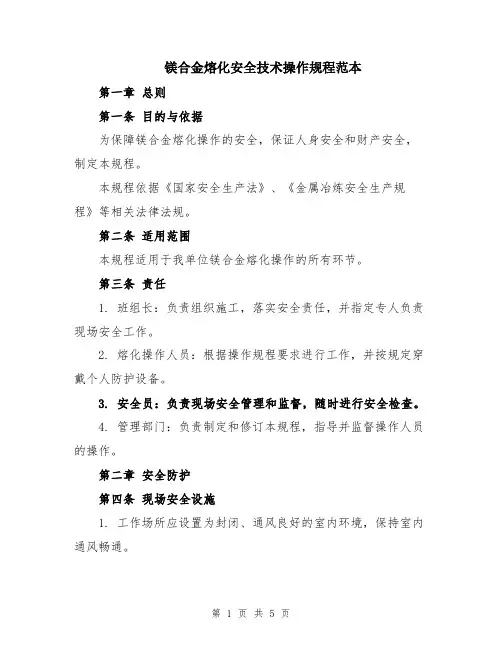
镁合金熔化安全技术操作规程范本第一章总则第一条目的与依据为保障镁合金熔化操作的安全,保证人身安全和财产安全,制定本规程。
本规程依据《国家安全生产法》、《金属冶炼安全生产规程》等相关法律法规。
第二条适用范围本规程适用于我单位镁合金熔化操作的所有环节。
第三条责任1. 班组长:负责组织施工,落实安全责任,并指定专人负责现场安全工作。
2. 熔化操作人员:根据操作规程要求进行工作,并按规定穿戴个人防护设备。
3. 安全员:负责现场安全管理和监督,随时进行安全检查。
4. 管理部门:负责制定和修订本规程,指导并监督操作人员的操作。
第二章安全防护第四条现场安全设施1. 工作场所应设置为封闭、通风良好的室内环境,保持室内通风畅通。
2. 熔化操作台面应固定、平稳,以防护熔化容器发生倾倒以及镁合金液体溅出。
3. 各种设备、工具、仪表的设置应与操作相匹配,保证正常工作。
4. 应配备足够的灭火器材和疏散设备,以备发生火灾或其他事故时使用。
第五条操作人员防护1. 操作人员必须佩戴适当的个人防护装备,包括防火服、防护手套、防护眼镜等。
2. 熔化过程中,操作人员应注意保持良好的工作姿势,避免操作失误。
3. 食品、饮品等零食禁止进入熔化作业现场,以防止发生意外事故。
第三章操作要点第六条熔炉设备准备1. 定期检查熔炉和加热设备的运行状况,如有异常情况及时修复。
2. 熔炉设备要严禁拆卸和乱动,必要时由专业人员进行维修和保养。
第七条熔化材料准备1. 严格按照操作规程要求,取得符合要求的镁合金材料。
2. 材料出库前应进行质量检查,并进行记录,确保材料符合要求。
3. 检查镁合金材料的水分含量,确保合金处于适宜的状态。
第八条熔化操作流程1. 操作人员在熔炉中加入适量的镁合金材料,并根据操作规程进行熔化。
2. 加热过程中要保持熔炉门关闭,并定期检查加热炉温度的稳定性。
3. 熔化过程中应保持操作人员的安全距离,防止熔化材料溅出伤及人员。
第九条废渣处置1. 熔炉中的废渣应及时清理,避免对设备和人员造成危害。
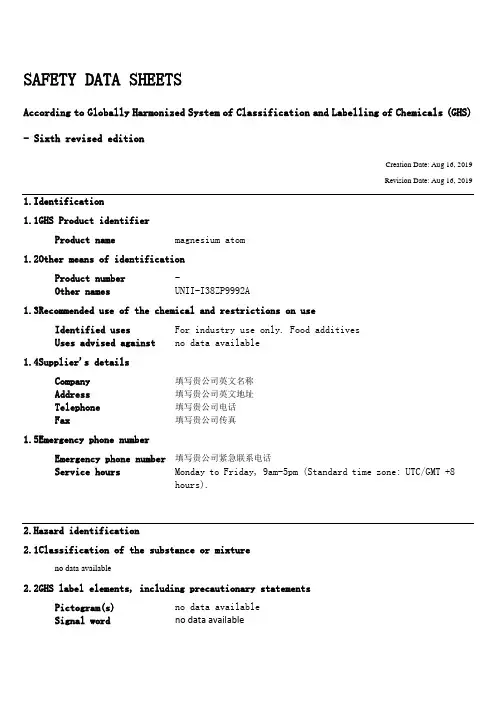
SAFETY DATA SHEETSAccording to Globally Harmonized System of Classification and Labelling of Chemicals (GHS) - Sixth revised editionCreation Date: Aug 16, 2019Revision Date: Aug 16, 20191.1GHS Product identifierProduct name magnesium atom1.2Other means of identificationProduct number-Other names UNII-I38ZP9992A1.3Recommended use of the chemical and restrictions on useIdentified uses For industry use only. Food additivesUses advised against no data available1.4Supplier's detailsCompany填写贵公司英文名称Address填写贵公司英文地址Telephone填写贵公司电话Fax填写贵公司传真1.5Emergency phone numberEmergency phone number填写贵公司紧急联系电话Service hours Monday to Friday, 9am-5pm (Standard time zone: UTC/GMT +8hours).2.1Classification of the substance or mixtureno data available2.2GHS label elements, including precautionary statementsPictogram(s)no data availableSignal word no data availableHazard statement(s)no data availablePrecautionarystatement(s)Prevention no data availableResponse no data availableStorage no data availableDisposal no data available2.3Other hazards which do not result in classificationno data available3.1Substances4.1Description of necessary first-aid measuresGeneral adviceConsult a physician. Show this safety data sheet to the doctor in attendance.If inhaledFresh air, rest.In case of skin contactRemove contaminated clothes. Rinse skin with plenty of water or shower.In case of eye contactFirst rinse with plenty of water for several minutes (remove contact lenses if easily possible), then refer for medical attention.If swallowedRinse mouth.4.2Most important symptoms/effects, acute and delayedDust irritates eyes in same way as any foreign material. Penetration of skin by fragments of metal is likely to produce local irritation, blisters, and ulcers which may become infected. (USCG, 1999)4.3Indication of immediate medical attention and special treatment needed, if necessaryMagnesium toxicity can be counteracted with calcium infusion.5.1Extinguishing mediaSuitable extinguishing mediaBurning of magnesium cannot be extinguished with water, carbon dioxide, halons or nitrogen ..., and more important, if these agents are used in fire-fighting, the hazardous situation will become even more severe. The only agents that can be applied successfully are the noble gases or in some cases boron trifluoride.5.2Specific hazards arising from the chemicalBehavior in Fire: Forms dense white smoke. Flame is very bright. (USCG, 1999)5.3Special protective actions for fire-fightersWear self-contained breathing apparatus for firefighting if necessary.6.1Personal precautions, protective equipment and emergency proceduresUse personal protective equipment. Avoid dust formation. Avoid breathing vapours, mist or gas. Ensure adequate ventilation. Evacuate personnel to safe areas. Avoid breathing dust. For personal protection see section 8.6.2Environmental precautionsRemove all ignition sources. Consult an expert! Personal protection: particulate filter respirator adapted to theairborne concentration of the substance. Sweep spilled substance into covered dry containers. Carefully collectremainder. Then store and dispose of according to local regulations. Do NOT wash away into sewer.6.3Methods and materials for containment and cleaning upPick up and arrange disposal. Sweep up and shovel. Keep in suitable, closed containers for disposal.7.1Precautions for safe handlingAvoid contact with skin and eyes. Avoid formation of dust and aerosols. Avoid exposure - obtain special instructions before use.Provide appropriate exhaust ventilation at places where dust is formed. For precautions see section 2.2.7.2Conditions for safe storage, including any incompatibilitiesFireproof. Dry. Well closed. Separated from other incompatible materials.Detached storage must be used for finely divided materials. Must be stored in a dry location. Isolate from halogens, acids, and oxidizing materials.8.1Control parametersOccupational Exposure limit valuesno data availableBiological limit valuesno data available8.2Appropriate engineering controlsHandle in accordance with good industrial hygiene and safety practice. Wash hands before breaks and at the end ofworkday.8.3Individual protection measures, such as personal protective equipment (PPE)Eye/face protectionSafety glasses with side-shields conforming to EN166. Use equipment for eye protection tested and approved underappropriate government standards such as NIOSH (US) or EN 166(EU).Skin protectionWear impervious clothing. The type of protective equipment must be selected according to the concentration andamount of the dangerous substance at the specific workplace. Handle with gloves. Gloves must be inspected prior touse. Use proper glove removal technique(without touching glove's outer surface) to avoid skin contact with thisproduct. Dispose of contaminated gloves after use in accordance with applicable laws and good laboratory practices.Wash and dry hands. The selected protective gloves have to satisfy the specifications of EU Directive 89/686/EECand the standard EN 374 derived from it.Respiratory protectionWear dust mask when handling large quantities.Thermal hazardsno data availablePhysical state silver or grey rod, turnings or ribbonColour Silvery-white metalOdour noneMelting point/ freezing651ºCpointBoiling point or initial1090°C(lit.)boiling point and boilingrangeFlammability Highly flammable. Gives off irritating or toxic fumes (orgases) in a fire.no data availableLower and upper explosionlimit / flammabilitylimitFlash point500ºC510°CAuto-ignitiontemperatureno data availableDecompositiontemperaturepH no data availableKinematic viscosity 1.25 cP @ melting pointSolubility INSOL IN COLD WATER, CHROMIUM TRIOXIDES; SOLUBLE IN MINERALACIDSno data availablePartition coefficientn-octanol/water (logvalue)Vapour pressure 1 Pa @ 428°C1.74g/mLat 25°C(lit.)Density and/or relativedensityRelative vapour density0.84Particle characteristics n o data available10.1Reactivityno data available10.2Chemical stabilitySLOWLY OXIDIZES IN MOIST AIR.10.3Possibility of hazardous reactionsMAGNESIUM FIRE: DO NOT FLARE UP VIOLENTLY UNLESS...MOISTURE PRESENT. DANGEROUS INFORM OF DUST OR FLAKES, WHEN EXPOSED TO FLAME OR BY VIOLENT CHEM REACTION WITHOXIDIZING AGENTS. ...SOLID FORM IS DIFFICULT TO IGNITE...IT MUST BE HEATED ABOVE ITSMELTING POINT... FINELY DIVIDED FORM...MAY BE IGNITED BY SPARK OR FLAME...OR EVENSPONTANEOUSLY WHEN...DAMP, PARTICULARLY WITH WATER-OIL EMULSION. DURINGMACHINING, MAGNESIUM FIRES RESULT FROM USE OF DULL CUTTING TOOLS, MACHINING WITHLIGHT CUT AT HIGH SPEEDS OR RUBBING OF TOOL ON WORK AFTER CUTTING OPERATION ISFINISHED.Dust explosion possible if in powder or granular form, mixed with air. If dry, it can be chargedelectrostatically by swirling, pneumatic transport, pouring, etc.MAGNESIUM slowly oxidizes in moist air. Reactsvery slowly with water at ordinary temperatures, less slowly at 100°C. Reacts with aqueous solutions of dilute acidswith liberation of hydrogen [Merck 11th ed. 1989]. In the presence of carbon, the combination of chlorine trifluoridewith aluminum, copper, lead, magnesium, silver, tin, or zinc results in a violent reaction [Mellor 2, Supp. 1. 1956]. Amixture of powdered magnesium with trichloroethylene or with carbon tetrachloride will flash or spark under heavyimpact [ASESB Pot. Incid, 39. 1968]. Stannic oxide, heated with magnesium explodes [Mellor 7:401. 1946-47].When carbon dioxide gas is passed over a mixture of powdered magnesium and sodium peroxide, the mixtureexploded [Mellor 2:490. 1946-47]. Powdered magnesium plus potassium (or sodium) perchlorate is afriction-sensitive mixture [Safety Eng. Reports. 1947]. An explosion occurred during heating of a mixture ofpotassium chlorate and magnesium [Chem. Eng. News 14:451. 1936]. Powdered magnesium can decomposeperformic acid violently [Berichte 48:1139. 1915]. A mixture of finely divided magnesium and nitric acid isexplosive [Pieters 1957. p. 28]. Magnesium exposed to moist fluorine or chlorine is spontaneously flammable[Mellor 4:267. 1946-47].10.4Conditions to avoidno data available10.5Incompatible materialsIncompatible with ethylene oxide, metal oxosalts, oxidants, and potassium carbonate.10.6Hazardous decomposition productsViolent decomposition with evolution of hydrogen chloride can occur when 1,1,1-trichloroethane comes into contact with magnesium or its alloys with aluminum.Acute toxicity•Oral: no data available•Inhalation: no data available•Dermal: no data availableSkin corrosion/irritationno data availableSerious eye damage/irritationno data availableRespiratory or skin sensitizationno data availableGerm cell mutagenicityno data availableCarcinogenicityno data availableReproductive toxicityno data availableSTOT-single exposureno data availableSTOT-repeated exposureno data availableAspiration hazardno data available12.1Toxicity•Toxicity to fish: no data available•Toxicity to daphnia and other aquatic invertebrates: no data available•Toxicity to algae: no data available•Toxicity to microorganisms: no data available12.2Persistence and degradabilityno data available12.3Bioaccumulative potentialno data available12.4Mobility in soilno data available12.5Other adverse effectsno data available13.1Disposal methodsProductThe material can be disposed of by removal to a licensed chemical destruction plant or by controlled incinerationwith flue gas scrubbing. Do not contaminate water, foodstuffs, feed or seed by storage or disposal. Do not dischargeto sewer systems.Contaminated packagingContainers can be triply rinsed (or equivalent) and offered for recycling or reconditioning. Alternatively, thepackaging can be punctured to make it unusable for other purposes and then be disposed of in a sanitary landfill.Controlled incineration with flue gas scrubbing is possible for combustible packaging materials.14.1UN NumberADR/RID: UN1869IMDG: UN1869IATA: UN186914.2UN Proper Shipping NameADR/RID: MAGNESIUM or MAGNESIUM ALLOYS with more than 50% magnesium in pellets, turnings or ribbonsIMDG: MAGNESIUM or MAGNESIUM ALLOYS with more than 50% magnesium in pellets, turnings or ribbonsIATA: MAGNESIUM or MAGNESIUM ALLOYS with more than 50% magnesium in pellets, turnings or ribbons14.3Transport hazard class(es)ADR/RID: Not dangerous goods.I MDG: Not dangerous goods.I ATA: Not dangerous goods.14.4Packing group, if applicableADR/RID: Not dangerous goods.I MDG: Not dangerous goods.I ATA: Not dangerous goods.14.5Environmental hazardsADR/RID: no IMDG: no IATA: no14.6Special precautions for userno data available14.7Transport in bulk according to Annex II of MARPOL 73/78 and the IBC Codeno data available15.1Safety, health and environmental regulations specific for the product in questionInformation on revisionCreation Date Aug 16, 2019Revision Date Aug 16, 2019Abbreviations and acronyms•CAS: Chemical Abstracts Service•ADR: European Agreement concerning the International Carriage of Dangerous Goods by Road•RID: Regulation concerning the International Carriage of Dangerous Goods by Rail•IMDG: International Maritime Dangerous Goods•IA TA: International Air Transportation Association•TWA: Time Weighted Average•STEL: Short term exposure limit•LC50: Lethal Concentration 50%•LD50: Lethal Dose 50%•EC50: Effective Concentration 50%。

镁MSDS 新版化学品安全技术说明书化学品安全技术说明书修改日期:产品名称:镁MSDS编号:版本:1.0第一部分:化学品及企业标识化学品中文名:镁化学品英文名:magnesiumCAS No。
7439-95-4EC No。
231-104-6分子式:Mg分子量:24.31g/mol企业名称:企业地址:邮编:传真:联系电子邮件地址:企业应急第二部分:危险性概述紧急情况概述:镁是固体,易燃。
其粉末与空气混合能形成爆炸性混合物。
在空气中容易发生自热反应,有引发火灾的危险。
与水接触会生成高度易燃气体。
危险性类别(GB-2013):自热物质和混合物,类别1(粉末);遇水放出易燃气体的物质和混合物,类别2;易燃固体,类别2.标签要素(GB-2013):警示词:危险危险信息:易燃固体;自热,可能燃烧;遇水放出易燃性气体。
防范说明:远离热源、火花、明火和热表面,严禁吸烟。
不得与空气和水接触,在惰性气体中操作。
避免产生扬尘。
佩戴防护手套、防护眼罩和防护面具,穿防护服。
事故响应:如皮肤沾染,掸掉皮肤上的细小颗粒。
浸入冷水中或用湿绷带包扎。
火灾时使用干砂、干粉灭火。
安全存储:存放于干燥处。
存放于密闭的中。
内装物存放于惰性气体中。
废弃处置:本品及的处置应遵循地方/国家法规规定。
第三部分:成分/组成信息成分:镁含量:99%XXX:7439-95-4第四部分:急救措施皮肤接触:立即脱去污染的衣着,用大量流动肥皂水和清水冲洗,如有不适,就医。
眼睛接触:提起眼睑,用清水冲洗,如有不适,就医。
吸入:迅速脱离现场至空气新鲜处,保持呼吸道通畅,如呼吸困难,给输氧。
如呼吸停止,立即进行心肺复苏术,就医。
食入:禁止催吐,切勿给失去知觉者从嘴里喂食任何东西,就医。
对保护施救者的忠告:泄漏物质如果被水污染,可能会产生易燃气体。
因此,必须在有排风的内收容泄漏物,并尽快废弃处理。
在清除所有火源的同时,要增强通风,避免接触皮肤和眼睛,并使用防护装备,包括呼吸面具。
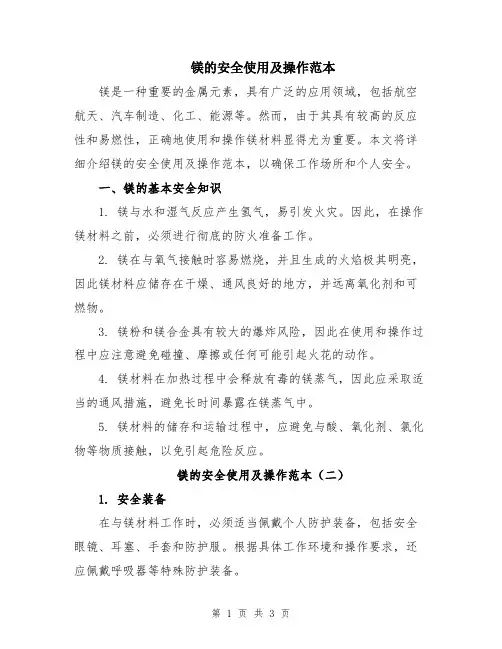
镁的安全使用及操作范本镁是一种重要的金属元素,具有广泛的应用领域,包括航空航天、汽车制造、化工、能源等。
然而,由于其具有较高的反应性和易燃性,正确地使用和操作镁材料显得尤为重要。
本文将详细介绍镁的安全使用及操作范本,以确保工作场所和个人安全。
一、镁的基本安全知识1. 镁与水和湿气反应产生氢气,易引发火灾。
因此,在操作镁材料之前,必须进行彻底的防火准备工作。
2. 镁在与氧气接触时容易燃烧,并且生成的火焰极其明亮,因此镁材料应储存在干燥、通风良好的地方,并远离氧化剂和可燃物。
3. 镁粉和镁合金具有较大的爆炸风险,因此在使用和操作过程中应注意避免碰撞、摩擦或任何可能引起火花的动作。
4. 镁材料在加热过程中会释放有毒的镁蒸气,因此应采取适当的通风措施,避免长时间暴露在镁蒸气中。
5. 镁材料的储存和运输过程中,应避免与酸、氧化剂、氯化物等物质接触,以免引起危险反应。
镁的安全使用及操作范本(二)1. 安全装备在与镁材料工作时,必须适当佩戴个人防护装备,包括安全眼镜、耳塞、手套和防护服。
根据具体工作环境和操作要求,还应佩戴呼吸器等特殊防护装备。
2. 防火措施在进行任何与镁材料有关的工作之前,必须确保工作区域干燥通风,并清除所有可燃物和火源。
如果需要使用明火,应使用隔热材料将镁材料包裹起来,以防止火焰蔓延和燃烧过程中释放出的高温。
3. 爆破风险控制对于具有爆炸风险的镁粉和镁合金,应制定详细的操作程序和控制措施。
在操作过程中,应避免使用机械或工具对其进行过度振动、撞击或压力。
4. 通风措施针对释放有毒镁蒸气的情况,应确保工作场所具有良好的通风条件,保持空气流通。
如果可能,可以使用排风设备或通风系统来控制镁蒸气的浓度。
5. 废物处理和清洁在使用和操作镁材料后,必须正确处理废弃物和污染物。
镁废物应储存在密封的容器中,并妥善处理。
工作区域应定期进行清洁,确保没有任何可燃物、杂物或污染物残留。
6. 应急准备在发生事故或紧急情况时,必须掌握相应的应急处置程序和应急设备的使用方法。
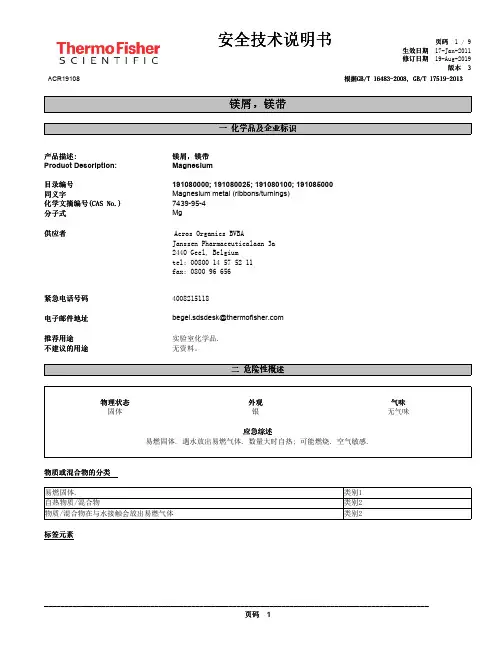
镁屑镁屑,,镁带安全技术说明书页码 1 / 9生效日期 17-Jan-2011修订日期 19-Aug-2019版本 3ACR19108根据G B /T 16483-2008, G B /T 17519-2013一 化学品及企业标识产品描述:镁屑镁屑,,镁带Product Description:Magnesium目录编号191080000; 191080025; 191080100; 191085000同义字Magnesium metal (ribbons/turnings)化学文摘编号(C A S N o .)7439-95-4分子式Mg供应者Acros Organics BVBAJanssen Pharmaceuticalaan 3a 2440 Geel, Belgium tel: 00800 14 57 52 11fax: 0800 96 656紧急电话号码4008215118电子邮件地址推荐用途实验室化学品.不建议的用途无资料。
二 危险性概述物质或混合物的分类标签元素应急综述易燃固体. 遇水放出易燃气体. 数量大时自热; 可能燃烧. 空气敏感.易燃固体.类别1自热物质/混合物类别2物质/混合物在与水接触会放出易燃气体类别2物理状态固体外观银气味无气味警示语危险危害声明H228-易燃固体H252-数量大时自热;可能燃烧H261-遇水放出易燃气体防范说明预防P210-远离热源/火花/明火/热表面。
禁止吸烟P231+P232-在惰性气体中操作。
防潮P235+P410-保持低温。
防日光照射P240-容器和接收设备接地/等势联接P280-戴防护手套/穿防护服/戴防护眼罩/戴防护面具。
响应P335+P334-掸掉皮肤上的细小颗粒。
浸入冷水中/用湿绷带包扎。
P370+P378-火灾时: 使用D类灭火器进行灭火储存P402+P404-存放于干燥处。
存放于密闭的容器中P407-垛/托盘謡T S间应留有空隙。
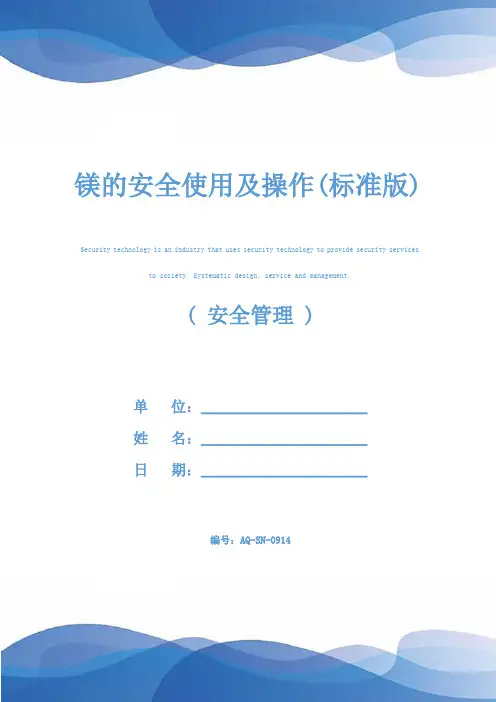
镁的安全使用及操作(标准版)Security technology is an industry that uses security technology to provide security services to society. Systematic design, service and management.( 安全管理 )单位:______________________姓名:______________________日期:______________________编号:AQ-SN-0914镁的安全使用及操作(标准版)镁在某些形式下,如薄带子,非常容易点燃。
在固态下,诸如镁锭,要让其燃烧是很难的。
镁是一种优良的热导体,而且作为实物,在其点燃前,整个件必须加热到接近熔点温度。
通常这种情况不会发生,除非这块固体镁被其它来源的大火包围。
当镁处于下列状态时,必须采取注意措施:-处于熔融状态-细状,如屑,颗粒或细粉-被火焰笼熔融镁1、安全服和设备和任何其它物体一样,熔融镁在600°C下一旦与你的皮肤接触,将会造成严重的烧伤。
那些工作在熔融镁周围的人必须穿戴足够的防护服和设备。
这包括:-防护眼镜-带防护屏的安全帽-阻燃工作服-安全鞋-绝热长防护手套所有安全服和设备都需经过测试以确保防护是足够的。
急救预备物应包括火焰覆盖和安全指示器。
所有人身防护设备都应符合适用的法定标准。
2、熔液的保护熔融镁暴露于空气时会着火和燃烧,因此,在熔炼作业中,它必须要加以保护。
传统的办法是覆盖流态化氯盐,排除空气与熔液的接触。
当今通用的做法,虽不是全部的,是使用一种保护气体,诸如少许六硫化氟与空气的混合气体,或者空气和二氧化碳的混合气体。
六硫化氟或者SF6在熔液表面形成一层膜以防止过分氧化。
3、气体供给系统气体供给系统应设计成防止熔液上面有高浓度六硫化氟形成,因为高浓度六硫化氟会严重腐蚀钢制炉盖和熔炼锅。
镁合金熔化安全技术操作规程镁合金是一种具有轻质、高强度和良好的机械性能的材料,广泛应用于航空、汽车和电子等领域。
然而,由于其低熔点和易燃的性质,对于镁合金的熔化工作需要特殊的安全技术操作规程。
下面是一个关于镁合金熔化安全技术操作规程的____字详细说明:一、概述镁合金熔化工作需要严格遵守安全操作规程,以预防火灾和事故的发生。
本文将从镁合金材料的性质、熔化设备的选择和使用、火灾预防和应急处置等方面详细介绍镁合金熔化安全技术操作规程。
二、镁合金材料的性质镁合金的熔点相对较低,易燃且火焰温度高,因此在熔化过程中需要特别注意防火措施。
此外,镁合金还具有易氧化的特点,容易与空气中的氧气发生反应,因此需要在惰性气氛下进行熔化工作。
三、熔化设备的选择和使用1. 熔炉选择:应选用具备良好耐火性和隔热性能的炉体材料,确保炉体不产生热裂纹并能够承受高温的侵蚀。
同时,炉子的内部应设置耐高温的反应层,以减少反应产物对炉子的腐蚀和污染。
熔炉的外部应设置防热层,以防止辐射热对熔炉周围环境的影响。
2. 熔炉操作:熔炉应进行定期的维护保养工作,确保炉体的正常运行。
在熔化过程中,应定期检查炉体的温度和压力,避免出现异常情况。
同时,应按照操作手册的要求进行炉体的升温和降温,避免温度过高或过低造成设备的损坏。
3. 熔炉保温:在熔化过程中,需要对熔炉进行保温,以减少能量的损失和环境的影响。
保温材料应具备良好的热稳定性和隔热性能,并能够耐受高温和腐蚀。
同时,应定期检查保温材料的完整性和性能,确保其正常工作。
四、火灾预防措施1. 熔化环境控制:在熔化过程中,应保持熔炉内的环境干燥,并尽量降低空气中的氧气含量,以减少镁合金与氧气的反应。
可以使用惰性气体作为熔炉内的气氛,例如氮气或氩气。
2. 防火设施准备:熔化现场应配备消防器材和防火用品,如灭火器、灭火器、防火涂层等。
同时要定期检查这些设施的有效性,并进行维护和更换。
3. 电气设备安全:熔化现场的电气设备应符合相关的安全标准,并定期进行维护和检测。
镁合金的安全操作示范文本In The Actual Work Production Management, In Order To Ensure The Smooth Progress Of The Process, And Consider The Relationship Between Each Link, The Specific Requirements Of EachLink To Achieve Risk Control And Planning某某管理中心XX年XX月镁合金的安全操作示范文本使用指引:此操作规程资料应用在实际工作生产管理中为了保障过程顺利推进,同时考虑各个环节之间的关系,每个环节实现的具体要求而进行的风险控制与规划,并将危害降低到最小,文档经过下载可进行自定义修改,请根据实际需求进行调整与使用。
由于镁的易燃易爆性,在生产中必须要对安全有足够的重视,以下是个人防护、设备安全防护、事故处理要点。
一、个人防护个人防护是从事镁合金作业的基本条件,一般情况下,下面的防护装备是镁合金压铸人员的基本保护用品:1.工作服2.安全帽3.防护面罩4.隔热石棉手套5.防火衣裤(耐热700℃以上)6安全鞋操作人员在进行作业以前,一定要按上述要求穿戴防护用品,未穿戴防护用品的人员不要靠近作业区域,不能进行操作。
二、设备安全防护镁合金熔炉不能使用含镍的不锈钢,同样熔炼工具也不可使用含镍的不锈钢。
炉体最好有双层结构的设计,当内层坩锅破裂时,镁液可流到内外层之间的夹层中,同时报警停止加热,使熔化的镁液不至流到外面造成危险。
要经常检查炉子有无锈蚀,如有锈蚀应及时清理.镁合金压铸生产过程中,最重要的是保持现场的干燥、干净。
每次开机前应将模具预热到150℃以上,喷涂时不要喷涂过多的涂料,以免型腔内积水,引起危险。
另外冲头及模具的冷却尽量不要用水冷。
冲头的冷却可用风冷,模具的加热及冷却一般用耐高温油。
镁合金压铸冲头速度也比铝合金压铸的高,为避免飞料伤人,有时在模具上分型面部位加装飞料挡板。
镁的安全使用及操作范本镁是一种常见的金属元素,具有广泛的应用领域。
然而,由于其化学性质的特殊性,使用和操作镁需要遵循一定的安全规范。
本文将介绍镁的安全使用和操作的范本,以帮助人们更好地掌握正确的方法,确保工作场所的安全。
1. 仔细阅读相关资料和说明书。
在使用镁之前,务必仔细阅读相关的资料和说明书,了解镁的性质、特点、存储要求以及安全操作方法。
掌握这些基本信息对于安全使用镁至关重要。
2. 制定详细的操作计划。
在进行任何涉及镁的操作之前,制定一个详细的操作计划是必要的。
该计划应包括所需材料和设备的清单、操作步骤的详细描述以及相应的安全注意事项。
这样能够帮助人们在操作过程中更加清晰地了解每个步骤,从而减少操作中的风险。
3. 穿戴适当的个人防护装备。
在使用镁的过程中,应穿戴适当的个人防护装备。
这包括穿戴耐酸碱的防护服、戴上安全帽和护目镜、戴上耐酸碱手套和安全鞋等。
这些防护装备能够有效地减少对镁可能产生的危害,保护人们的身体安全。
4. 确保操作环境通风良好。
在进行镁的操作时,务必确保操作环境通风良好。
镁在与空气接触时会产生高温和有毒气体,因此需要保持良好的通风条件,将有害气体及时排除。
5. 使用合适的工具和设备。
在操作镁时,应选择合适的工具和设备。
使用专业的设备能够帮助人们更好地控制操作过程,并减少意外风险的发生。
例如,在进行焊接操作时,应使用专用的焊接设备和工具。
6. 避免与其他物质接触。
镁在与氧气、水和酸等物质接触时会产生化学反应,释放出有害气体和可能引发火灾的废气。
因此,在使用镁的过程中,应尽量避免与上述物质接触,以减少事故风险。
7. 控制使用量和储存条件。
在使用镁时,应根据需要合理控制使用量,并注意合理储存。
避免过量使用和储存过多的镁,以免引发潜在的安全隐患。
储存镁时应选择干燥、通风良好的地方,并远离火源和其他易燃物。
8. 防止镁粉尘的扩散。
镁粉尘是一种易燃的物质,可以迅速引发火灾。
因此,在操作镁时,应采取措施防止镁粉尘扩散。
镁的安全使用及操作模版镁是一种常见的金属元素,具有多种用途,包括制造合金、防腐蚀材料和烟火等。
然而,由于其易燃性和反应活性,使用和操作镁时需要采取一系列安全措施。
本文将详细介绍镁的安全使用和操作的模板。
第一部分:介绍1.1 镁的特性和用途(介绍镁的基本信息以及常见的使用领域)1.2 安全使用和操作的重要性(强调安全使用和操作的必要性)第二部分:镁的物理和化学性质2.1 物理性质(介绍镁的外观、密度、熔点等物理特性)2.2 化学性质(介绍镁的反应性、易燃性等化学特性)第三部分:危险性和风险评估3.1 镁的危险性(介绍镁的危险性,包括易燃性和反应性)3.2 风险评估(分析使用镁可能存在的风险,并评估其对人身安全和环境的潜在风险)第四部分:安全使用和操作指南4.1 镁的储存和保管(介绍镁的储存条件和要求)4.2 使用镁的安全措施(介绍使用镁时需要采取的安全措施,如穿戴个人防护装备和遵守操作规程等)4.3 灭火方法(介绍如果发生镁火灾时如何处理,包括使用合适的灭火剂等)4.4 废弃物处理(介绍如何妥善处理使用过的镁材料)第五部分:事故处理和急救措施5.1 镁的泄露和事故处理(介绍如何处理镁的泄露和其他可能发生的事故)5.2 镁的急救措施(介绍在发生与镁相关的事故时应该采取的急救措施,如使用灭火器和寻求医疗帮助等)第六部分:镁的安全培训和教育6.1 培训计划(建议制定一个针对使用镁的员工的培训计划,包括安全意识教育和操作技能培训等)6.2 安全宣传(介绍如何通过安全宣传活动提高员工对镁安全使用和操作的意识)第七部分:案例分析和经验分享7.1 镁相关事故案例分析(介绍一些与使用镁相关的事故案例,并分析其原因和教训)7.2 经验分享(邀请一些专业人士分享他们在使用镁过程中的经验和教训)第八部分:结论8.1 简要总结(总结镁的安全使用和操作的重要性以及所要采取的安全措施)8.2 展望(展望未来,进一步加强对镁安全使用和操作的研究和实践)这个模板可以作为一个指导,根据具体需要进行修改和完善。